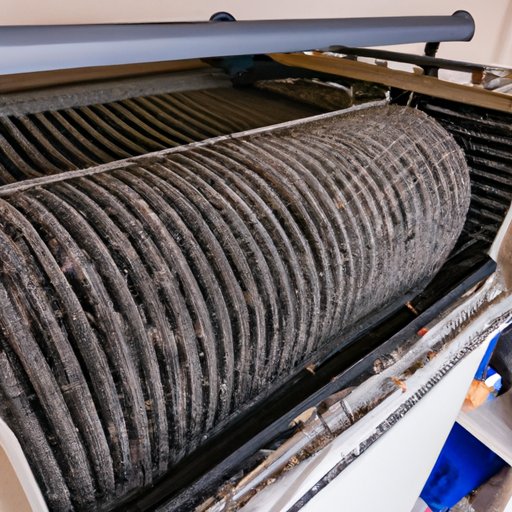Introduction
One of the most important maintenance tasks for homeowners with central air conditioning systems is cleaning the AC coils. AC coils play a crucial role in the functioning of an HVAC system and keeping them clean can have a significant impact on the system’s efficiency, lifespan, and energy bills. This article provides a comprehensive guide with step-by-step instructions on how to clean AC coils safely and effectively, whether you choose to do it yourself or hire a professional HVAC technician.
Importance of Cleaning AC Coils
Dirty AC coils can reduce the efficiency of the cooling system by forcing it to work harder to maintain the desired temperature in the home. This not only leads to an increase in energy bills but can also cause undue wear and tear on the unit, leading to premature breakdowns and costly repairs. Regular cleaning of AC coils can extend the lifespan of the AC unit and improve its performance efficiency.
Step-by-Step Guide for Cleaning AC Coils
Before beginning the cleaning process, it is crucial to turn off power to the unit to prevent any electrical accidents. The coils can then be accessed either through the front or back of the unit. Some tools to have on-hand include a soft-bristled brush, a vacuum cleaner, a garden hose, and safety gear like gloves and safety glasses.
To start, use the soft-bristled brush to gently remove any debris or dust present on the coils. Next, use a vacuum cleaner to remove any stubborn debris or dust build-up on the coils and surrounding areas. Once the coil surface is clear of debris, use a garden hose to wet the coils, being careful not to damage the fins.
To remove any remaining dirt, use a commercial coil cleaner designed for air conditioning systems or a solution of equal parts water and vinegar or baking soda. Apply the solution to the coils and let it sit for 5-10 minutes before rinsing it off with a garden hose. Be sure to allow the coils to dry completely before turning the power back on and restarting the system.
DIY Cleaning Methods
For homeowners looking for natural cleaning solutions, vinegar and baking soda are excellent options for cleaning AC coils. To use vinegar or baking soda, mix one part vinegar or baking soda with one part water and apply the solution to the coils using a spray bottle or sponge. Allow the solution to soak for 5-10 minutes before rinsing with water.
For more stubborn debris or dust build-up, commercial coil cleaners specifically designed for air conditioning systems are available. These cleaners are effective in dissolving dirt and grime without damaging the coils or fins, but should only be used by homeowners with experience in handling chemicals and following safety precautions.
Hiring a Professional
Hiring a professional HVAC technician can save homeowners time and effort while ensuring a thorough cleaning of the AC coils. HVAC technicians have the tools and experience necessary to handle the cleaning safely and efficiently, preventing any damage to the unit or injury to the homeowner. Additionally, HVAC technicians can perform a more comprehensive assessment of the system and identify potential issues before they become costly repairs.
Prevention Tips
One of the most effective ways to reduce the need for frequent cleaning of AC coils is to change air filters regularly. Clogged air filters can cause dirt and debris to accumulate on the coils, requiring more frequent cleanings. Other preventative measures include installing a programmable thermostat to reduce energy usage and scheduling regular maintenance appointments with an HVAC technician to ensure the system is running efficiently and effectively.
Signs of Dirty AC Coils
Reduced airflow, strange noises coming from the unit, or higher than usual energy bills are all warning signs that AC coils need cleaning. Detecting these signs early can prevent further damage to the system and ensure optimal performance efficiency.
Common Mistakes to Avoid
One common mistake homeowners make when cleaning AC coils is using the wrong cleaning materials. Using harsh chemicals or abrasive tools can damage the coils and fins, reducing the overall performance efficiency of the system. To avoid this, only use materials recommended by HVAC manufacturers and follow the safety precautions outlined in the user manual.
Conclusion
Cleaning AC coils is an essential maintenance task for homeowners with central air conditioning systems. By following the step-by-step instructions outlined in this guide, homeowners can clean the coils safely and effectively, improve the efficiency and lifespan of the system, and reduce energy bills. Remember, if you are unsure about cleaning AC coils or notice any problems with your HVAC system, always consult with a professional HVAC technician.
